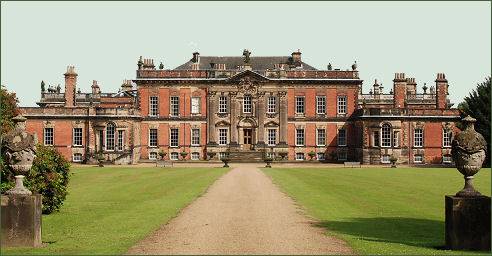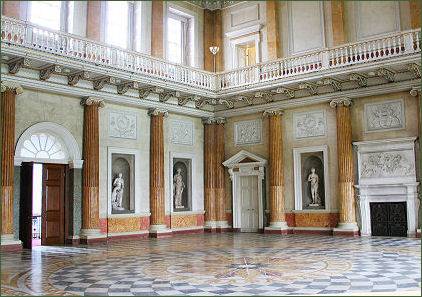Wentworth Woodhouse
OS grid reference:- SE 506 071
 Wentworth Woodhouse stands in the picturesque village of Wentworth, about 4 miles from Rotherham.
Wentworth Woodhouse stands in the picturesque village of Wentworth, about 4 miles from Rotherham.
The house's east front measures 606 feet (180metres) long, making it the longest country house fašade in Europe. The house covers an area of over 2.5 acres (1.0 ha), nearly one and a half football pitches, is twice as wide as Buckingham Palace and is surrounded by a an estate of 15,000 acres.
It was originally a Jacobean country house, and was the home of Charles 1st's ill-fated administrator, Thomas Wentworth, 1st Earl of Strafford. whom Charles I sacrificed in 1641 to appease Parliament. The original house was rebuilt in the English Baroque style by Thomas Watson-Wentworth, 1st Marquess of Rockingham (1693-1750) who inherited the property from his father, the Hon. Thomas Watson.
The building was later vastly enlarged, making the old house just a wing of the new, by his son Charles Watson-Wentworth, the 2nd Marquess of Rockingham, who was twice Prime Minister.
 In the eighteenth century Wentworth Woodhouse, with all its contents, passed to the family of the Marquess's sister, the Earls Fitzwilliam. William Wentworth-Fitzwilliam, the 4th Earl Fitzwilliam, who was the inspiration behind Mr Darcy in Jane Austen's famous novel 'Pride and Prejudice' while the house is thought to be Mr Darcy's family pile of Pemberley in the book. King George V and Queen Mary stayed at the house for 4 days in 1912.
In the eighteenth century Wentworth Woodhouse, with all its contents, passed to the family of the Marquess's sister, the Earls Fitzwilliam. William Wentworth-Fitzwilliam, the 4th Earl Fitzwilliam, who was the inspiration behind Mr Darcy in Jane Austen's famous novel 'Pride and Prejudice' while the house is thought to be Mr Darcy's family pile of Pemberley in the book. King George V and Queen Mary stayed at the house for 4 days in 1912.
The Whistlejacket Room was named for George Stubbs' portrait that hung in it of Whistlejacket, one of the most famous racehorses of all time. The Pillared Hall contains fine neoclassical statues, the Marble Hall measures sixty feet across and forty foot high and was known in the 1760s as the finest room in England. The corridors are so long that in the Victorian era, guests were given baskets of confetti to lay a trail to guide them back to their rooms.
No less than 21 follies stand in the grounds including the Needle's Eye, Hoober Stand, Keppel's Column, the Mausoleum, the Ionic Temple and Doric Temple, the Vinegar Stone, and the Bean Seat.
In April 1946, on the orders of Manny Shinwell, the then Labour Party's Minister of Fuel and Power, a large part of the estate was mined for coal. The area between the house and the Rockingham Mausoleum became the largest open cast mining site in Britain at that time. By 1989 the house and the 70 acres (280,000 m2) surrounding it were sold to Wensley Grosvenor Haydon-Baillie, who commenced a programme of restoration, however a business failure caused it to be repossessed by a Swiss bank and put back on the market in 1998, when it was purchased by Clifford Newbold (1926 - 2015) an architect from Highgate.
